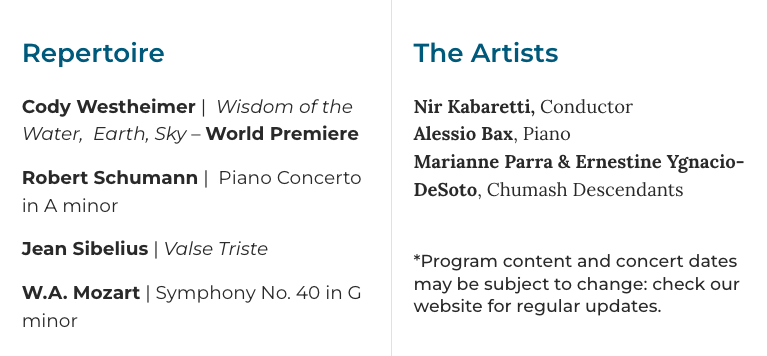Santa Barbara Symphony program notes November 19-20 2022: Wisdom of the Sky, Water, Earth
Visit the Santa Barbara Symphony
Visit conductor Nir Kabaretti’s website
Visit composer Cody Westheimer's New West Studios website
Visit pianist Alessio Bax’s website
Read my review of the November 19 2022 concert
Wisdom of the Sky, Water, Earth
A dusting of bittersweet sadness worries conductor Nir Kabaretti’s musical choices for the November 19 and 20 concerts. Partnering with the Santa Barbara Museum of Natural History and the Santa Ynez Band of Chumash Indians, the world premiere of Santa Barbara composer Cody Westheimer’s Chumash folklore-centered new work, Wisdom of the Sky, Water, Earth, is an examination of the tribe’s culture and animist origin stories. European masterpieces on the program also address loss; things once present, now relegated to tradition, or memory, or hallucination.
Robert Schumann’s Piano Concerto in A minor, Op. 54 (1845), Jean Sibelius’ Valse Triste (Sad Waltz), Op. 44, No. 1 (1903), and Mozart’s enigmatic Symphony No. 40 in G minor, K. 550 (1788) share the program with the Westheimer piece, and tell their own stories, obvious and opaque, of intuitive regret, loss that is known yet left unspoken. The sub-basement stuff of the human condition.
Robert Schumann’s gift to his beloved Clara, the Piano Concerto in A Minor, cannot escape, for all its energy and celebration, the poignant presence of self-doubt, perhaps a foreknowledge in 1845 the year of the concerto’s composition, of the inevitable outcome of the composer’s debilitating struggle with depression and insanity that ultimately led to his suicide in 1856. Jean Sibelius’ Valse Triste (Sad Waltz), Op. 44, No. 1 (1903) is a heartbreaking tale of loneliness, aging, and abandonment. It is also one of the most beautiful short works for small orchestra in the repertoire.
An alcoholic, Sibelius knew of sadness, and the melancholy tonal temperament of Valse Triste is, like the composer’s alcoholism, a slow waltz with death. Mozart’s “Great” G minor Symphony No. 40, K. 550 (1788) composed three years before his passing in 1791, gives up some of its secrets in plain sight, like its key of G minor, a red flag for tonal sadness. Like the A minor tonality in the Schumann concerto, these two minor keys are used with purpose by composers to express unhappiness. In 1788 Mozart’s bills were a tsunami, while ticket sales for his performances were slacking off; plenty of reason to be bummed.
Santa Barbara-born composer Cody Westheimer (1979-), whose first serious orchestral composition was premiered by the Santa Barbara Symphony when he was 17, has an impressive portfolio of music he has composed for feature films, documentary series, and iconic sports events, like his Tour de France theme on NBC. While at USC's Thornton School of Music he composed the music for nearly 40 short films, and graduated Magna Cum Laude in 2001, while concurrently completing USC's Film Score Certification program. Since then, he has written hundreds of hours of music for independent narrative features, documentaries, network and cable television shows, movies, and video games.
Now living once more in Santa Barbara, Westheimer is an avid environmentalist, land preservationist, and nature photographer, in addition to his work as a composer. Westheimer has engaged with the Chumash people on various environmental projects over the years. The commission to compose a World Premiere piece of musical and narrative art honoring the Chumash and their rich heritage of ancient Wisdom of the Sky, Water, Earth, is a particular honor for the composer.
Through-composed like a tone poem, Wisdom of the Sky, Water, Earth has six discernible sections within its one-movement format: Introduction; Water: Dolphin; Earth: Deer; Earth: Squirrel; Sky: Hawk; and Epilogue. “The music is sculpted by my perception of their personalities,” Westheimer explains of the four animals and their profound messages to mankind. Each Chumash parable will be read in English and Chumash by tribe descendants, Marianne and Ernestine. “These Chumash people’s stories have served as creative inspiration for my music and have tremendous relevance today,” Cody shared. “The first people on this land got it right, we must learn from and honor their legacy.”
German composer Robert Schumann (1810-1856) enjoyed a major career as a music critic, literary authority, and virtuoso pianist in addition to his output as a composer, but his path to success was slow to kick in and short-lived. A child of the Napoleonic catastrophe in Europe (1803-1815) he experienced the destruction, displacement and chaos, both psychological and physical, wrought by the nineteenth century’s first world war. Wellness and career became a constant struggle for the composer, ending sadly, in insanity and suicide by 1856.
Studying piano with Friedrich Wieck, Schumann fell rather compulsively in love with Wieck’s daughter Clara, herself a brilliant concert pianist/composer. In her father’s eyes, Schumann was not financially adequately stable to marry and support his daughter, refusing entreaties to permit marriage. A battle royale between Robert Schumann and Friedrich Wieck wracked its way through several years of nastiness and litigation. Finally in 1840, Robert and Clara married.
Finished in 1845, the composer’s wedding gift to his wife, the Piano Concerto in A minor, Op. 54, is one of the most widely performed piano concertos in the repertory of the Romantic period. The first movement, Allegro affettuoso, was played publicly as early as 1841, and is a stand-alone powerhouse of abundant melody and gushing passion in adoration of his wife’s tremendous talent.
Still, interrupting at least one of several churning passages of exhilaration, a nearly funereal tune in oboe and horns, soon dispelled but nevertheless haunting; a “nagging headache” of premonition, as the composer would describe the first onset episodes of his mental collapse.
It’s hard to imagine a better way to express love between two people than the second movement of the work, Intermezzo – Andantino grazioso, which breaks all previous rules about what a second movement in a three-movement concerto from that period should be. Traditionally slow, quite often an Adagio, Schumann expresses his love for the beloved Clara with a lighthearted and flirtatious movement, gushing, swooning, taking walks in the park hand in hand, the musical imagery is unmistakable.
The movement segues like butter on hot toast directly into the last movement, Allegro vivace, which confidently states the composer’s love for his wife in grand postnuptual manner, particularly the magnificent coda and last big brass chord at the very end, à la Berlioz.
Pianist Alessio Bax has been a regular and favorite guest artist in Santa Barbara for several years. Settling in the United States in 1994, Bax lives in New York City with his pianist wife, Lucille Chung and daughter Mila. He has been a member of the piano faculty at Boston’s New England Conservatory of Music since 2019. Awarded an Avery Fisher Career Grant in 2009, and four years later both the Andrew Wolf Chamber Music Award and the Lincoln Center Award for Emerging Artists, Bax tours throughout the world on a regular basis as a chamber music colleague and concerto/recital soloist.
Originally one of a six-movement set of incidental pieces for small orchestra Finnish composer Jean Sibelius (1865-1957) composed in 1903 for a rather gruesome play, Kuolema (Death), by his brother-in-law Arvid Järnefelt, Valse Triste (Sad Waltz), Op. 44, No. 1, immediately took on a life of its own as an independent concert piece, and has remained popular to this day.
Despite its rather depressing portrait in music of a bittersweet last waltz shared with already dead friends who appear during the final delirium of a dying woman’s life, Valse Triste begins delicately, and sustains beautifully, a languorous, sadness-tinged waltz tune that mesmerizes. There are occasional bursts of energy as the woman tries to maintain her failing energies, then a final, frantic dervish before the dying woman collapses and the piece fades away. Easily among the most famous and frequently performed of his works, Sibelius was cheated of his royalties for Valse Triste.
Austrian composer Wolfgang Amadeus Mozart (1756-1791) likely died of renal failure exacerbated by the stress of his last, poverty-chased years. As the programmatic superstructure of this Santa Barbara Symphony concert pair so poignantly illustrates, stress, unhappiness, regret, and loss often produce great art. Mozart’s last years, while troubled, saw the creation of a considerable number of his most compelling masterpieces, including the Symphony No. 40 in G minor, K. 550 (1788), composed three years before his death.
Like so many artistic works created by humans under personal or cultural stress, the opposite emotion is often expressed. The Symphony No. 40 is a masterpiece of joy and innovation on its surface, though tinted in the colors of the more introverted, darker tonality of G minor. There are other subtle indicators of a troubled subtext, including readily identifiable orchestral sighs that characterize the rhythmic pulse of the first movement, Molto allegro, and the solemn pace and funereal dotted rhythms of the second movement, Andante. The third movement, Menuetto. Allegretto – Trio, while delightfully animated and light, is concurrently insistent and aggressive, mellowed only by the delicacy and slower tempo of the movement’s Trio section. Segueing immediately into the last movement, Finale – Allegro assai, Mozart creates another of his signature compositional finale’s, sparkling with brilliant jollity, clever invention, and intricate contrapuntal devices.
Daniel Kepl | Performing Arts Review

Music and Artistic Director Nir Kabaretti




Download a PDF of the program notes

Composer Cody Westheimer

Wisdom of the Sky, Water, Earth - Nir Kabaretti and Cody Westheimer discuss the inspiration


Cody Westheimer's score for The Grand Reset - Earth 2020 - COVID-19 and Climate Crisis - Earth Day Video PSA


Pianist Alessio Bax

Johannes Brahms seated and Robert Schumann

Robert and Clara Schumann

Johannes Brahms in his 20's

Finnish composer Jean Sibelius

Sibelius in his last years
